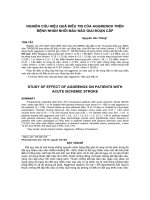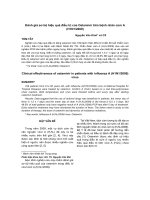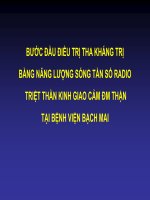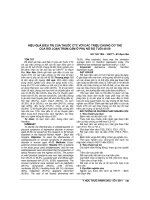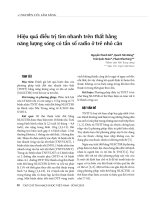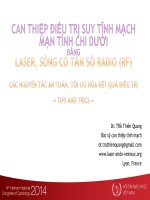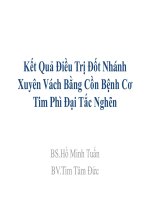Hiệu quả điều trị tim nhanh trên thất bằng năng lượng có tần số radio ở trẻ nhỏ cân
Bạn đang xem bản rút gọn của tài liệu. Xem và tải ngay bản đầy đủ của tài liệu tại đây (551.84 KB, 20 trang )
22-14/10/2014
14
ĐẠI HỘI
TIM MẠCH TOÀN QUỐC
Trung tâm hội nghị quốc tế ICC
Đà nẵng, Việt Nam
The results of radiofrequency ablation in
infants and small children with
supraventricular tachycardia
Nguyen Thanh Hai, MD*; Quach Tien Bang, MD*;
Tran Quoc Hoan*; Pham Nhu Hung,MD, PhD**
*National Hospital of Pediatrics
**National Heart Institute, Bach Mai Hospital
Introduction
Supraventricular Tachycardia (SVT):
Most common abnormal tachycardia seen in
pediatric practice (Incidence up to 1:250 children)
Most common arrhythmia requiring treatment in
pediatric population
Most frequent age presentation: 1st 3 months of life,
2nd peaks at 8-10 and in adolescense
Indian Pacing Electrophysiol J, 2005; 5(1): 51-62.
Radiofrequency Ablation (RFA) Role
1. An alternative to chronic antiarrhythmic drug
therapy.
2. The standard therapy for SVT in adolescents with
symptomatic tachycardia
3. Infants and children < 4 year old or weight < 15
kg are independent risk factors for complications
associated with RFA
Indian Pacing Electrophysiol J, 2005; 5(1): 51-62.
RFA in Infants and Small Children
• Antiarrhythmic drug:
– The first-line treatment for small children
• Controversy about safety of RFA
– Previous study (Kugler et al, 1997): Infants and children < 4 year old or
weight < 15 kg are independent risk factors for complications
associated with RFA
– Some recent studies show conflicting data
• Indication for RFA:
– Recurrent hemodynamically compromising drug-resistant SVT
– Tachycardia-induced dilated cardiomyopathy
Indian Pacing Electrophysiol J, 2005; 5(1): 51-62.
Objective
• To evaluate the efficacy and safety of RCA in
infants and small children
Method
• Retrospective study
• Eligible patients:
– All pts underwent RFA for SVT in NHP
• Group I: Pts ≤ 15 kg
• Group II: Pts > 15 kg
– From Aug 2012 to Aug 2014
• Recorded patient data
Method
• Primary endpoints:
• Acute procedural success
– Absence of tachycardia or pre-excitation for 24 hours after RFA
• Chronic success
– Acute procedural success and freedom of tachycardia symtoms during
follow-up.
• Procedural safety
– Absence of serious complications associated with RFA within 2 days of the
ablation procedure and no AV Block during follow-up
• Clinical follow-up:
– 1, 3, and every 6 months after procedure
Data analysis
Using SPSS 22.0
•
•
•
The chi-square method for categorical variables
The t-test for continuous variables
A p value of £ 0.05 was taken to denote a significant difference.
Results
Baseline patient characteristics
Group I
Group II
P
Age (years; mean ± SD)
2.2±1.4
8.6±2.9
< 0.001
Weight (kg; mean ± SD)
11.1±3.0
28.1±8.4
< 0.001
Gender (%Nam)
55.6
62.2
0.6
Structral heart Diseases (%)
22.2
2.7
0.03
EKG with manifest WPW
72.2
42.2
0.04
Electrophysiology study and
radiofrequency ablation data
Group I
Group II
p
Substrate Ablation (% left-sided)
36.8
35.0
0.089
Tachycardia mechanism (% AVRT)
88.9
67.6
0.089
275 ± 35
319 ± 53
0.002
17.1 ± 12.4
17.7 ± 16.2
0.882
263 ± 132
346 ± 288
0.148
Fluo Time (min)
32.1 ± 18.4
23.0 ± 18.9
0.093
RFA maximum temperature (C)
55.5 ± 6.3
56.2 ± 6.6
0.581
Total procedure time (min)
102 ± 35
109 ± 37
0.672
Cycle length (ms)
No. of RFA applications
RFA total time (sec)
Outcome of RFA
Group I
Group II
p
7.7 ± 5.6
11.3 ± 6.5
0.03
Acute success rate (%)
94.4
90
0.08
Recurrence rate (%)
11.8
21.6
0.01
Follow-Up (manths)
No. of major complication
0
No. of dead
0
Guideline for Indication
Class I:
1.
WPW syndrome following an episode of aborted sudden cardiac
death.
2.
WPW syndrome with syncope and
3.
Syncope short pre-excited RR interval during atrial fibrillation (preexcited R-R , 250 ms)
Or the antegrade effective refractory period of the AP measured
during programmed electrical stimulation is , 250 ms.
Chronic or recurrent SVT associated with ventricular
dysfunction.
PACE, 2002; 25: 1000-17
Guideline for Indication
Class IIa
1
2
3
4
5
Recurrent and/or symptomatic SVT refractory to
conventional medical therapy and age > 4 years.
Impending congenital heart surgery when vascular or
chamber access may be restricted fol- lowing surgery
Chronic (occurring for . 6–12 months following an initial
event) or incessant SVT in the presence of normal
ventricular function
Chronic or frequent recurrences of intra-atrial reentrant
tachycardia.
Palpitations with inducible sustained SVT during
electrophysiological testing.
PACE, 2002; 25: 1000-17
Guideline for Indication
Class IIb:
1.
Asymptomatic WPW w/ age >5 years, with no recognized
tachycardia, when the risks and benefits of the procedure and
arrhythmia have been clearly explained.
2.
SVT, age >5 years, as an alternative to chronic antiarrhythmic
therapy which has been effective in control of the arrhythmia.
3.
SVT, age < 5 years, when antiarrhythmic medications are not
effective or associated with intolerable side effects.
4.
IART, one to three episodes per year, requiring medical
intervention.
PACE, 2002; 25: 1000-17
Argument against RFA
1.
2.
3.
Risk for major complication
Technical issues with RFA in small hearts
The potential unknown long-term effects
Indian Pacing Electrophysiol J, 2005; 5(1): 51-62.
Argument in favour RFA
Greater difficulties with medical management
Higher rate of drug refractory therapy and side effect
The higher risk for hemodynamic compromise
during tachycardia in infants with CHD
Un- effective communication, the children
become more seriously ill
Indian Pacing Electrophysiol J, 2005; 5(1): 51-62.
Pediatric Radiofrequency Ablation
(RFCA) Registry Data
• Kugler et all (1997), data from 1991–1997
( Including 4135 pts (0-21 year old)
Body weight < 15kg: the risk of major complication
Am J Cardiol, 1997; 80(11): 1438-43
• Blaufox et al (2001), data from 1989–1999
( Including 137 infants < 15 kg vs 5960 older children)
–No significant differences were found for complication and success rates
between infants and noninfants
Circulation 2001; 104(23):2803-8
Single center outcome of RFA
Blaufox et al Aiyagari et
(2004)
al (2005)
Akdeniz et An et al
al (2013)
(2013)
Hai et al
(2014)
No. of pts
12
25
5
24
18
Weight (kg)
<15
< 15
(<4 yrs.
old)
< 15
Acute success
rate
9/11
96
No
different
94.4
4/5
Recurrence rate
11.8
Major
complication
2
(Pericardial
perfusion,
myocardial
infarction
)
2 (atrial
perforation
s)
Dead
No
No
NG
No
Np
No
Conclusion
RFA may be safe and reliable
with good success rate
Thank you

